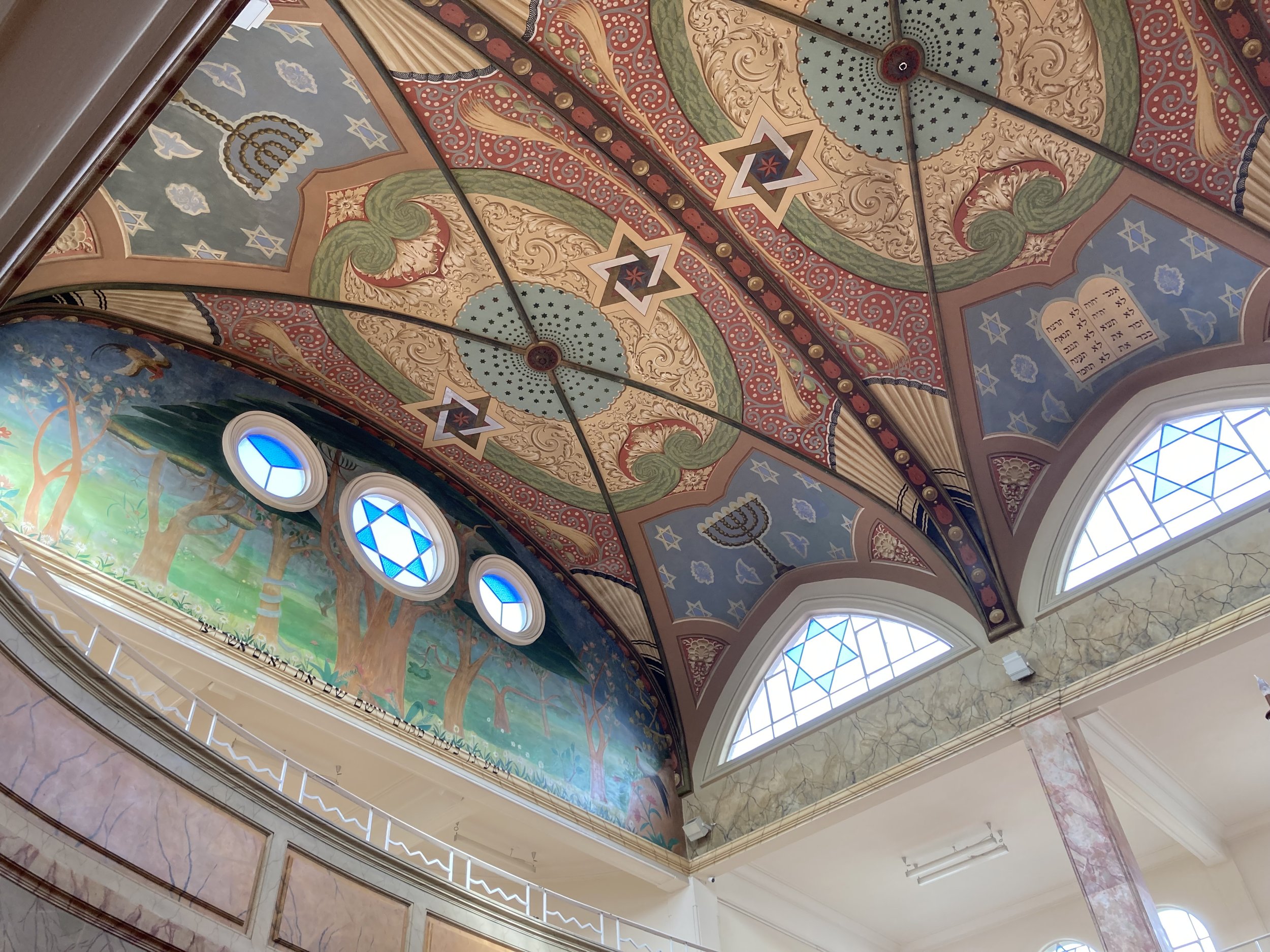[image description a restaurant menu for Masala y Maiz with black cartoon dinosaur holding two wine glasses. the text reads: Viva Palestina Libre! No es guerra, es genocidio!! Cese al fuego ya!! End the apartheid! End the genocide! Ceasefire now!]
I’m still digesting my amazing first visit to Mexico City. The fanciest meal I enjoyed was at Masala y Maiz, which “explores the migration of people, culinary techniques, ingredients, cultural food ways and political movements between South Asia, East Africa & Mexico.” Besides being extremely delicious, their menu carried an important message about solidarity and freedom for Palestine. I’m including this because it reflects the lens through which I held a visit to a historic synagogue.
[image description: the outside facade of the synagogue, a red brick wall with grey brick trim, and wooden doors with subtle stars of david on the top. a small hisotrical marker reads “Espacio dedicado a la cultura judía en México. Fue la tercera sinagoga del país y la primera construida para la comunidad ashkenazí.” Translated to English it means “This building is dedicated to the Jewish culture in Mexico. It was the third synagogue built in Mexico and the first by the Ashkenazi community.]
[image description: the inside facade of the synagogue, a three-story white building with blue stained glass accents]
On the outside, Sinagoga Justo Sierra, matches its neighborhood’s Spanish architecture via colonization. It blends into the neighborhood but for the stars of david on the wooden doors. This synagogue was built in 1941 by Lithuanian, Polish, and Russian immigrants who carried the impacts of anti-semitism in their bodies. They had learned to survive, and even though Mexico City was much safer for Jews than their home countries, they built a synagogue in 1941 with a “double facade” - Spanish architecture on the front office giving way to an entirely separate building in the back which is more recognizable as a synagogue.
[image description: inside of the synagogue, wall panels are pained to mimic marble. the second floor is a balcony once designated for the gender segregation of women. moving upwards, a stained glass star of david is inlaid among a painting of trees. the bright and busy ceiling is painted ornately with red, yellow, green, and blue colors including stars of david, menorahs, and many beautiful patterns.]
The colors and designs inside were stunning, modeled after a Lithuanian temple but full of the vibrant color palates common to Mexico. Similar to many synagogues built in the 19th and 20th centuries, it was designed not only as a place of worship but also as a community center. Throughout the space, there were taped-up black and white photos of members celebrating events like bat mitzvahs, weddings, and holidays. Jewish communities have a much longer history in Mexico, varying based on specific Jewish ethnic groups.
[image description: two black-and-white photos taped to the synagogue wall. one picture is of a number of people seated for a formal dinner, the other photo appears to depict a wedding party posing for a photo.]
Sephardi Jews began immigrating to Mexico from Spain and Portugal after the inquisition started in 1492. Over the next 300 years, that inquisition cut into Mexico, suppressing all non-Catholic spirituality and most Jews were literally or figuratively forced to convert. In the 1890s-1910s the Ottoman Empire fell, bringing Sephardic Jews from Syria and other formerly-Ottoman states to Mexico. Around the same time, Ashenazi Jews came from Eastern Europe where they faced escalating pogroms (riots/attacks.) Like many other Jewish communities across the world, these culturally distinct groups were not necessarily united by the commonality of their struggles.
As I continue learning about Jewish history outside of the U.S, I've also appreciated doing my own reflection and growth - making it personal, local, and immediate. In an online course with Jen Kiok via White Awake, I was reminded of Jo Kent Katz’s Map of Internalized Antisemitism for White Ashkenazi Jews in the U.S.
There is something about the facade of the Sinagoga Justo Sierra in Mexico City that resonates. it reminds me of the internalized trauma and fear I am witnessing and experiencing as U.S. Jews grapple with what it means to hold oppression in one hand and power in the other.
[mezuzah means doorpost in Hebrew, and symbolizes commitment to God and/or blessing the home; it is traditionally touched or kissed each time one enters the building or room. the mezuzah pictured shows years of use where it’s outermost point shines brighter than the rest because it’s been touched so many times.]
I appreciated this framing from Jo Kent Katz, regarding the internalized antisemitism map:
“Exploring the content of this map in parallel with patterns of internalized white superiority can assist white Ashkenazi Jews in noticing, naming, and interrupting the ways we participate in, and perpetuate, both racism and anti-Semitism within Jewish community and beyond.
Over many decades, in various countries, and very actively here in the U.S., Ashkenazi Jews of European descent, carrying deep ruptures of loss and trauma, collectively abandoned fields of language, music, plant medicine, folk magic, and spiritual and religious expression for the safety and security that assimilation into white Christian hegemony promised.”
As I continue my own learning and unlearning, I am grateful for all kinds of maps. Literal maps and figurative ones. Maps that help us locate ourselves and find our way forward.





